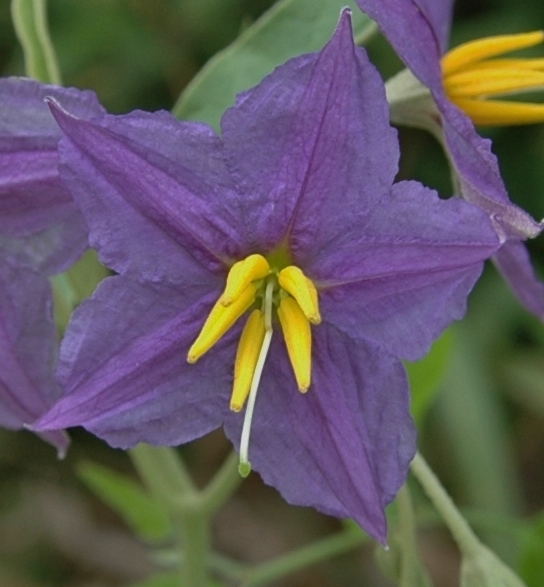
Story and Photos by Anita Westervelt, Texas Master Naturalist
Nightshades are a peculiar family of plants. With nearly 2,300 species worldwide, they range from exceedingly nutritious to dangerously poisonous.
Nightshade plants belong to the Solanacaea family of plants; most are toxic. The primary toxin is solanine.
On the dark side, we get the deadly nightshade, Atropa belladonna, from Eurasia, a popular ladies’-choice weapon with authors of the classic British murder mysteries, the idea perhaps taken from historical events of ancient Rome.
On the edible end of the nightshade family are two of America’s most popular foods: French fried potatoes and tomato Ketchup. Along with tomatoes and both white and red potatoes, other edible, nutritious and economically important food crops in the nightshade family include hot and sweet peppers, eggplants and tomatillos. The fruit in these nightshade species is safe because the toxic compound is lowered to nontoxic levels once the fruits and vegetables ripen; the foliage and stems are never safe to eat as they contain concentrated amounts of the toxic alkaloids. With deadly nightshade, Atropa belladonna, all parts of the plant are poisonous whether the fruits are ripe or not.
On the wild side, about 100 species of nightshade can be found in North America. Other than those listed above as edible, twelve solanum species of nightshade occur naturally in Texas. The plants, although toxic to both humans and livestock, benefit the habitat in some way.
Of those found in the Valley, silverleaf nightshade (Solanum elaeagnifolium) is the showiest with its sturdy, grayish-green hairy leaves. The flowers are like a five-point starburst about an inch in diameter; their blooms are in clusters of dark purple to pale lavender flowers with yellow nectar guides and yellow stamen. Sometimes the petals are white. The fruit is a small, yellow berry that turns black. White-tailed deer, javelinas and birds eat the fruit; bobwhite quail eat the seeds. The plant reproduces by seed and from the roots.


Texas nightshade (Solanum triquetrum) is prevalent in the Valley. It is recognized by its spindly stems that can get quite tall, especially adjacent to a fence or supported by neighboring plants. The blooms are small white flowers with bright yellow stamen. The leaves are small elongated triangular shaped; the flowers face downward. The ripe berries are bright red about one-half inch in diameter.

Eastern black nightshade (Solanum ptychanthum) has been found locally. It is a multi-branched, upright plant with a growth height to four feet. The blooms are small white, quarter-inch drooping flowers with yellow anthers. Small green berries turn black when ripe; they are sometimes eaten by raccoons and rodents.

The flowers of these wild nightshades are occasionally visited by bees and butterflies, but they are not a remarkable nectar source. The foliage can sometimes be recognized by its odiferous leaves, like those of cultivated tomato plants; the powerful scent is a clue to the strong chemicals contained in the leaves and stems. Handling some nightshades may cause skin irritations; it is safer to wear gloves when working with nightshades, even domestic tomato plants.

